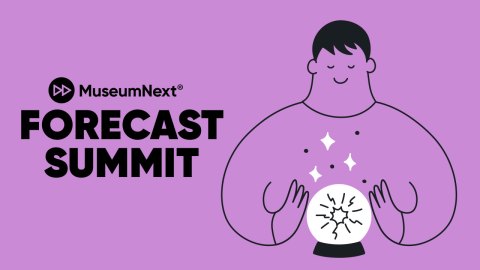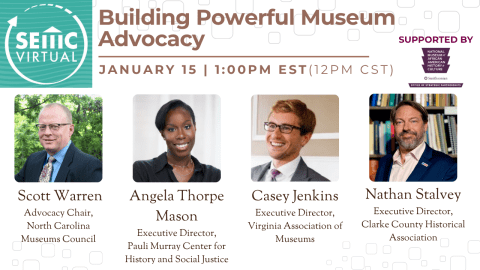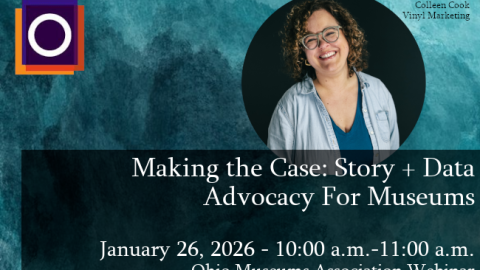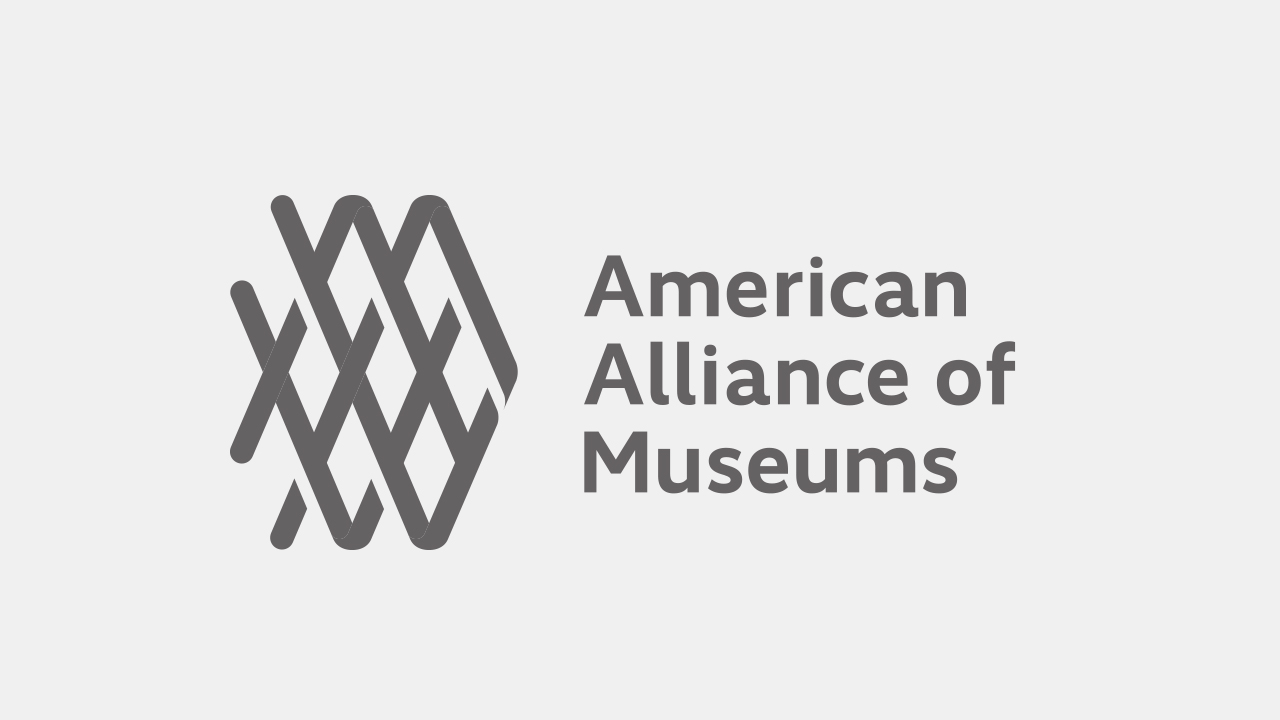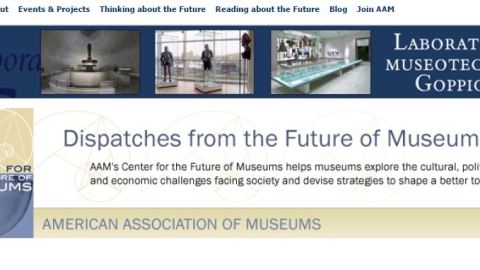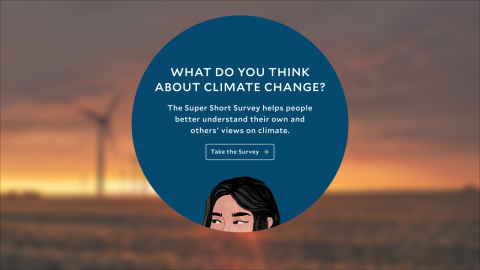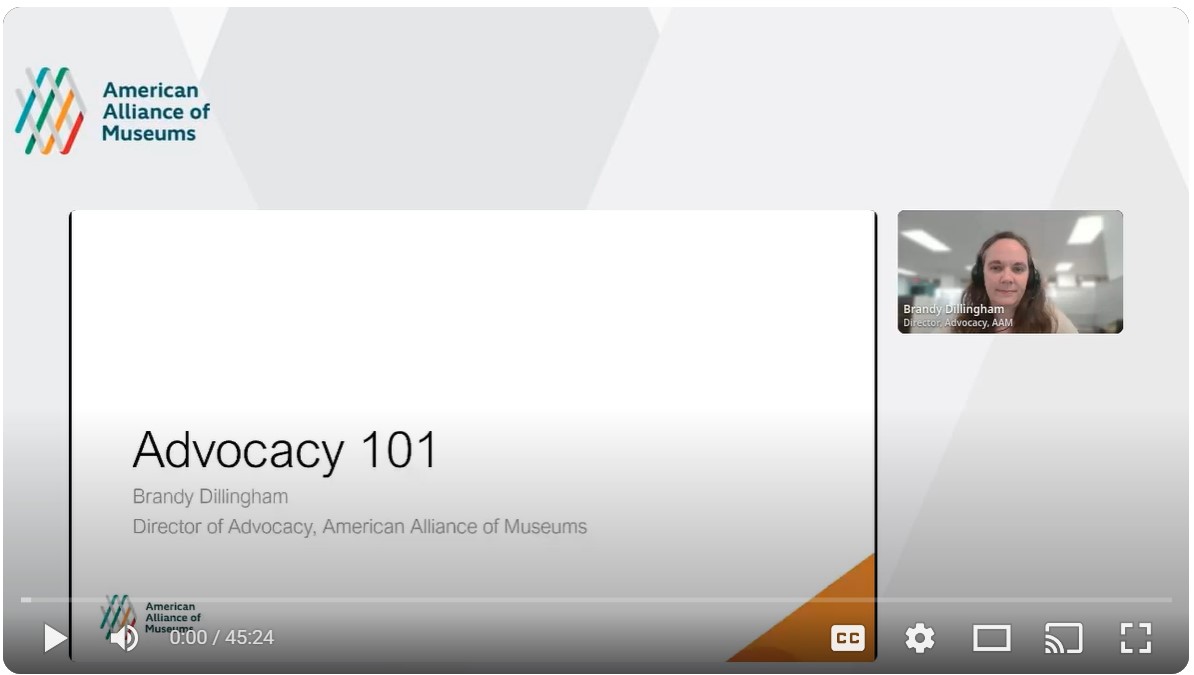
Interested in getting started in advocacy but don’t know where to begin? Do you wonder if your advocacy efforts make a difference? Join this webinar to learn more about advocacy, ways to have an impact, and learn more about Museums Advocacy Day.
Transcript
Brandy Dillingham:
Hello, everyone.
Welcome to the advocacy one hundred and one webinar. My name is . I’m director of advocacy for the American Alliance of Museums. Today’s webinar, we’re gonna focus on getting to know the basics of advocacy. If at any point during the webinar you have a question, please type it into the q and a box. And feel free to chat with each other in the chat box.
Okay. So let’s get started with some of the keys to advocacy.
The first one is education. And that’s and when I say education, I mean, educating both your lawmakers as well as educating yourself. So when I’m talking about educating yourself, I mean getting to know your lawmakers, getting to know the issues that impact you, and getting to know what’s going what’s going on.
Relationship building. It’s really important that you build relationships with your lawmakers and their staff. Your council member one day may become your member of congress. The staff person working for your for one of your lawmakers may end up running for office. And building up those relationships helps in the future.
You don’t want your first contact with your lawmaker to be when you really need them to do something major. You wanna start building that up so that when the time comes, you have already been giving them the information. They’re already familiar with you and your And then knowing the request. Knowing what you wanna ask them to do.
That is very important before you go into any interaction with lawmakers. And we are gonna go into more details on all of these topics. So a few things to keep in mind. Advocacy is a long term effort It’s not a one and done activity.
As I mentioned, building relationships is very important. And being able to develop those relationships is really impactful later on. And you never know when a topic is gonna come up. And so having already laid the groundwork is very impactful, over a long period of time.
All politics is local.
The fact is lawmakers wanna get reelected. And so as a constituent, you have power. And they wanna hear about what is impacting their constituent. So that they can make the right decisions.
So when you go to communicate with lawmakers, you wanna try to make it as local to the area that they represent. When you’re talking about your museum, you wanna talk about the local impacts you have. The, you know, the people you’re impacting. And we’ll talk a little bit more about that in just a moment.
And you’ll also find that sometimes when you wanna communicate with a lawmaker, and you’re not a constituent of theirs, they may be reluctant to take a meeting. So they do often prioritize constituents over folks from outside of their areas.
Economics and community impact This goes right into the all politics is local that I was just referring to. So you always wanna make sure that you’re highlighting the economic benefits of whatever issue you’re talking about and how your museum plays a role there. And this is where you can help get your board members involved, or even, like, the vendors you work with talking about how you’re impacting other businesses.
And tourism. So when we’re talking about economic impacts, those are the types of things we’re talking about. And keep in mind that the political landscape is always changing. So think about where we were a year ago, and keep in mind that a year from now, it could change again. Things are constantly changing. And you see this in legislation as well. You may be talking about a bill that, at the moment, has no chance of going anywhere. And then all of a sudden, the right circumstances come together, and there’s motivation to move us specific piece of legislation.
And so this is where coming back to the long term effort goes into play because you wanna have been laying that groundwork leading up to when that happened. So like I said, the landscape is always changing, so you never know when that opportunity is gonna come up. And you wanna make sure that you have already been building the groundwork for that before it comes up.
And we’re gonna get into more of that in just a moment.
So the most important thing you can do to prepare yourself for an interact with your lawmaker is to do your homework.
That is researching your elected officials, knowing your museum’s impact, knowing the museum data for your area or your state, and knowing the policies and legislation and how it impacts you.
Think of it like, it’s similar to how you would prepare yourself for a job interview. You would do your research on whoever you’re the company or the museum you’re interviewing with. You would do research on the person you’re interviewing with and what impacts you can bring to the job. It’s very similar to that. You’re researching your lawmakers, the impact your museum has. So think of it from that perspective.
And the question you probably have is, well, how do I research my elected officials? And what should I be looking for?
First thing I want you to keep in mind is that every elected official is different. Don’t think of them as their political party. Think of them as an individual. How am I gonna influence this individual?
Everybody is motivated by different things. Everybody’s constituents are different. And so what’s motivating them may differ from member to member. So always keep in mind that you should be thinking of them as an individual. So during your research, visit the lawmaker’s government web site.
It has most of the information that you’re probably looking for. And some of the issues you may be looking for is look for their key priorities.
What do they value most when they’re when they’re looking to do their legislation?
What is influencing them?
What are their committee assignments?
This is particularly impactful when you’re communicating with members of congress because committee assignments often will tell you what issues they have the most influence on.
And you can the same websites will tell you what the committee jurisdictions are so you can see specifically what they cover. For example, if your member of congress serves on the house appropriations committee. The appropriations committee is the ones that does the bills that funds the federal government. That member of congress is gonna have more influence on what appears in the funding bill.
And so that’s what I’m talking about when I say that those are the issues, they’re gonna have most influence on. Take a look at their bios.
Every lawmaker does their bio differently on their website. Some are more personal. Some are more policy and work focused. But you can often find some little nuggets that’ll be helpful to you if you’re looking to relate to some of their interest or you’re looking for if you’re going into a meeting with them that you’re looking for an icebreaker, sometimes you can find some little nuggets that are very helpful.
Read their press releases, sign up for their news, letters, follow them on social media, These are very helpful in understanding what their talking about, what they’re focused on, it even gives you an indication of what legislation is currently, the focus in congress. And this can be very helpful when you’re when you’re trying to determine what you know, where you may wanna focus your discussion on.
And do an Internet search. It all you have to do is type in their name and the word museum and just see what comes up. See what they’ve been saying. Have they visited museums lately? Are they talking about them?
You never know what you might get when you do when you do an Internet search. And something you might also want to when you’re looking at the sites if you’re, like, an executive director for a museum, you might look at it from the perspective of who from my museum might be the best representative for a particular meeting with the lawmaker. Like, maybe a board member might be a better fit if they have already built relationships So that’s something you might wanna keep in mind when you’re doing your research.
And your research can help you identify what programs of your museum you might wanna highlight if there’s a particular interest for a member. We were talking about committees. If they’re on the science committee and you’re a science center, maybe you wanna focus on STEM education. That’s an example of how you might wanna focus, your discussion And it’s important to know where you’re starting from and to set reasonable And this is something that you can determine through your research. Is knowing what’s their position on the topic you wanna discuss with them.
Are they supporting your position, or are they opposed? If they’re supporting your position, then you might not focus as much time on that particular issue. Do you still wanna talk about it, but you might wanna focus on a different area if they’re already in support.
However, if they’re opposed to your issue, it’s important to know why they’re opposed. Have they discussed that publicly? That could be helpful to you and when you’re trying to formulate your arguments. Knowing where you’re starting from.
And when I talk about setting reasonable expectations, if they’re opposed to your issue, you’re not gonna get them to do a one eighty off of one interaction with them. But what you might be able to do is to help clear up some misconceptions, give them a better idea of how the policy impacts their museums locally, how it’s impacting the community.
And it gives you a start a starting place. And sometimes it may be as the goal might be to keep them from introducing a bill that will do more damage if they’re opposed to your position. So you’ve gotta look at it from a different perspective. And, also, in your research, when you’re determining you know the topics you’re talking about, you might find that they’re supportive of your position on one issue and oppose your position on another issue. In that case, you might wanna focus more on where you might be able to change their
where you might be able to, like, fortify the position. So for example, during this past museum’s advocacy day, there were there are offices that were generally opposed to, you know, federal funding in general, and their would probably not support, the funding request we were making from for IMLS. However, many of those offices are supportive of tax incentives. To encourage charitable giving.
Which is something that’s also very important to museums. So that’s an area where you might be able to find common ground.
To work with them on. So keep that in mind when you’re during research. What are things that you might be able to find some common ground on?
Knowing your museum’s impacts. This can be very helpful. So this QR code that I have on here will take you to our advocacy resources page And on that page, amongst the resources we have, you will find there are sample economic and education impact statements. There’s templates and samples that you can use and use as a to see what might be helpful. Because you wanna be able to share what the impacts of your museums are to your community.
Whether and every museum is different, so what you choose to highlight might not be the same thing that’s on the examples, but they’re just but they’re there to help give you examples of things to think about. That’s everything from jobs you employ, the other businesses that you interact with, whether that’s your vendors or your visitors are eating at nearby restaurants. Those are the type of things to think about. Tourism, Keep those things in mind. Your educational role I mentioned earlier some education. So say you have a STEM education program, You know, one thing you can talk about is, like, US competitiveness and science and technology and how your museum is helping play a role in building up the science education in The US.
When you’re talking about education, don’t just focus on school groups. Also talk about the role that that benefits the those that do homeschooling and how you help those. Because you wanna make sure you give them a broad perspective. Things like veteran’s programs are very popular. So if you have one, whether it’s you have a lot of volunteers that are veterans or you have a specific program that’s geared towards them, those are types of things that you can highlight that shows your impact and value to the communities.
And knowing, museum data for your state and region, as I mentioned, all is local. So the more information you have about your other local, state, and regional museums is very important.
AAM does have museums as economic engines report, and you can pull states specific data. You can find a link to that on that resources page that the QR code was on. You will also see that QR code a few more times in these slides. So don’t worry if you miss it the first time.
You can also check with your state or regional museum association. Some of them do have state specific data that could be helpful to you, and, when you’re determining what kind of information you wanna share with the office.
You can also check if your if your museum associations do not have that specific data that you’re looking for. They may be able to help direct you to another organization that might. Sometimes the art the state arts and state humanities council may have information, your local visitors bureaus. So check with them and see if they have any data that could be helpful.
And you wanna integrate that generally into your story. I’m not saying you should focus only in that because you wanna talk about your museum story as well. But this is helpful data that that lawmakers tend to really respond well to.
And, also, make sure that your talking to other museums and knowing what other museums exist. You can check with some of the other museums in your city or your region to see if they have anything you can share. Especially if you’re doing, like, a meeting with a congressional office or your state legislator, it’s helpful to have some additional if they’re not able to attend. That way, you get a diversity of museum perspectives that you’re sharing with the office. And that can help give them a broader view.
Continuing to the education portion, as educating yourself, is knowing the policies and legislation that’s impacting you And there are a lot of ways to keep up to date on what’s going on. Obviously, the news is a good way to find out what policies and legislation is being considered whether at the state or local level or at federal level. AAM has our advocacy alerts. And I will the next slide actually has the QR code for the alerts if you don’t already get those. But we do share updates on what’s happening on the federal level. Some of your state and regional museum associations will have additional information on some of the state policies that are that are happening. It’s also helpful. Of those other organizations I mentioned earlier, like your state arts or humanities councils, may also have some state specific policies If you’re following their newsletters, that that could be helpful and staying up to date on what’s going on that impacts museums.
And make sure that you are familiar with the timing. Especially when we’re talking about, like, state legislators in particular, because they’re often many states are often like, have a very narrow time frame on when they’re doing And so it’s helpful to know when that’s at to sit be more mindful of what’s happening. Congress is in session pretty much all year long, but they do go home to their home desk districts, periodically. And that’s also helpful for you to know if you wanna connect with them when they’re back in their local districts. They are typically back in their districts for the entire month of August. Usually, the entire week of holidays. And, sometimes for long extended weekends, like four day weekends, they’ll be in their home districts visiting businesses, museums, and whoever reaches out to them wanting a meeting.
And this is the QR code to the alerts. If you are not familiar with those, it’s a good way to get updates on what’s going on the federal level AAM sends these out once a month. Usually, we will do them more free there is something very timely going on, if there’s, like, action immediately needed. And these alerts do include calls to action if you’re looking for ways to get engaged and involved.
And it includes advocacy tips as well if you’re not familiar.
So now let’s talk a little bit about different ways you can engage. We covered ways to prepare for your engagements and have that can be helpful to be more, to get more out of your interactions and how to be more effective. Now let’s focus a little bit on the different ways to engage. So there are in person and virtual meetings. And I’m gonna talk in more detail on separate slides in just a moment. Attending local events hosted by the lawmaker, what I mean by that is things like town halls, which can be very helpful if you’re trying to get a sense of what other issues are happening that are impacting other businesses because there’s often competing priorities with lawmakers. And so it’s helpful to know what other issues are catching their attention. And it’s a great way to get a question if you’re if you don’t have many opportunities to engage with lawmakers. It’s a good way to go, get a question in, hear what’s going on, hear their position, on topics. And they often have staff there as well, and it’s great way to interact with their staff.
Inviting your lawmaker to your museum. Which I’m gonna talk more about in just a moment, engaging through coalitions, and call, write, and share your newsletter. And I’m gonna talk about all of those in just a moment. So let’s talk about the in person or virtual meetings, and there’s a lot of different things you can do.
So there’s meetings in DC, such as Museum’s Advocacy Day, and I have a lot more details on in just a moment. If you have not been to a museum’s advocacy day, and I’m curious of what happens, I’ll talk about that in just a moment.
But there are also state hill days, AAM does not do those. However, there are numerous state museum associations that do state hill days. And it’s a great way to do something that’s part of an organized effort. And go to your state legislator and talk about some of the state policies impacting you.
And sometimes if your state museum association doesn’t do it, your state arts or other humanities or some associations in your state might do those. So it never hurts to look them up and see which ones are available. And like I said, that’s a really good way to do something as part of an organized effort. Especially if you haven’t done a lot of advocacy in the past. It can be helpful to go with a group for the first time.
District office meetings. Members of congress have offices locally. They have them in DC, but they also have them in their home districts. And their states as well. Sometimes more than one, senators will have multiple throughout the state, whereas representatives might have one or two. Depending on the size of their district. And you may be asking, what’s the difference of meeting with them in their district versus DC? A lot of that has to do with, a, the amount of time you might have with the member, but also the staff that you’re interacting with. So in a district office, the staff that works there, their job is to get to know the district and the local businesses, get to know the museums, get to know everything that’s going on locally. The DC staff, their job is to know the policy.
And to make recommendations on the policy. So it’s actually really helpful to know to get to know both staff in the district and in the DC offices. Because they are collecting different types of information and compiling it, and they have different expertise. And so it’s helpful to get to know both so that you’re in the conversation when both staff both staff positions are, bringing up certain things. So I do recommend, if you can, to connect with staff at both offices because they can be very helpful to you.
You can also do virtual meetings.
I will say in person it is far more impactful. However, not everybody can afford to travel to DC or their state legislators, so doing a virtual meeting is also an option.
And it can it still has an impact. It’s just the in person has a little bit more of an impact.
So I’m gonna talk a little bit about museum’s advocacy day. So for those who have not participated, I wanna give you a little insight into what that’s like and how that could be help helpful to somebody who has not been involved in who’s newer to advocacy and how that that could be helpful to you. Museum’s advocacy day in 2020 is gonna be February. We have not updated the website yet because we have not started registration. That’ll happen later this fall. So keep your eye out for those details and it should be early to mid-November.
When that’s released. What you will get is, before you come, you’ll get information on how to prepare yourself. You’ll get resource information. We do a pre event webinar to help prepare before you go, let you know what’s gonna happen. And then when you come on Sunday, there’s an opening reception, which is a great way to network. On Monday, there’s a day long program that does everything from, like, the policy ask. That’s basically what we’re gonna do and ask the members of Congress to support or oppose. There’s advocacy sessions, and how to get the most out of your meeting. There are a lot of other, policy and advocacy content through panels and other discussions throughout the day. And then you’ll end the day meeting with the group of attendees from your state.
Which is where you start to coordinate with each other especially if you’re doing meetings with, with some of those other attendees because we do try to keep folks together as much as we can. And it’s if you’ve never done, congressional meetings before, it’s a really helpful way, to get your that first interact in, especially if, you’re not quite sure how to go about it because you’ll be in a group with other folks, we do our best to try to make sure that there’s, someone who’s done it before in your group. And if there isn’t one, you can just ask staff, and we will come and attend the meeting with you so that you’re not alone. And that you have someone that’s experienced to help guide you through the meeting. And so these group meetings with your state is a great way to prepare You talk about, like, who’s gonna say what, how you’re gonna go about it, what point you’re gonna talk about.
And then on Tuesdays, the home meetings. AAM arranges all the meetings for the attendees, so you don’t have to do worry about any of that. And you spend the day going from meeting to meeting based on your house and senate members. And this can be a really good opportunity to see how congress works and to see how busy the offices are. It can give you a new perspective when you go to interact with them. You walk into an office, and the phones may be constantly ringing in the purse at the front desk is constantly answering the phone.
It may be so busy that you’re taking meetings in the hallway because the office has so many meetings that day. You may have to go over to a committee meeting because the staff person is also trying to staff the member of congress in a meeting. So you may have to take a meeting, in a place you weren’t planning to. That does sometimes happen. And it can be helpful to see all the other groups that are also doing home meetings that day because everybody has their name badges with what organization they’re with. And you can see what some of the other competing priorities are. And it definitely gives you a little bit of a different perspective on how busy things tend to be. And it’s also good to know, doing home meetings can also be a good professional development opportunity. You’re doing a lot of communications.
You’re networking, you’re getting to work with a group of folks to come up with how you’re gonna talk through the day, and it’s a great way to learn how to be concise. A lot of times meetings are shorter than you may think that they are, and so you have to often, like, be very concise in what you’re gonna say and get to the point in some cases. So it can definitely be a learning opportunity. And then Tuesday ends with, it can congressional reception. This reception does take place on Capitol Hill, and members of congress and their staff are invited. So that’s just a little insight into how a museum advocacy day works and some of the benefits somebody who’s not familiar with advocacy could get from it. And if you are already involved in advocacy, it’s a great way to continue to develop those relationships with the congressional offices.
I mentioned earlier inviting lawmakers to your museum. We just wrapped up our invite congress, which was, in August. As I mentioned earlier, members of congress are in their home districts in the month of August. And so inviting lawmakers to your museum is a great way for them to see firsthand the work that you do. It’s a great way to see the impact you have on your community. They can see, you know, everything that goes into some of your exhibits. If you’ve gotten let’s say, it’s a state lawmaker and you just completed an exhibit that was using state funds, It’s a nice way to show them what those funds went to. Especially if you’re going to be in the future, like, asking that the that the state legislator can continue to support state funding for those programs.
And you could do everything from, like, a tour of your museum or a specific exhibit, inviting them to the opening of a new exhibit, that doesn’t take a whole lot of effort. You just submit the invite. They may show up. They may not. Same with inviting them to events. And inviting them to see a program in action. If you’ve got a really great education program and you wanna show your staff working with a group of kids or your volunteers working with a group of kids, that’s a great way to show, like, the impact that you’re having in your community. And it really can have an impact.
Engaging through coalitions. So there may be coalitions that already exist.
Some of the, as I mentioned, like, museum associations or arts and humanities. But there you could consider building a coalition with other museums locally, in your, if you’re in a bigger city you could build within your city. Or if you’re, like, in a county and there’s, like, multiple small museums, coming together helps amplify your voice. So that’s a great option if you’re if you don’t have a lot of time and resources. You can instead work together with a group. You don’t have to do everything alone. Working together, especially if you have common goals. And it doesn’t even have to be in museums. Like, if you’re trying to raise awareness of a particular policy that’s impacting you that might be related to, a local ordinance? Work with you can have a coalition with other business to talk about that one ordinance. So else of the box. Every there are a lot of different ways you can go about amplifying your voice while working with coalitions.
Calling and writing. This is the simplest and easiest, most the least time commitment. Option for advocacy. It I will say the in person meetings and the visits to your museums, those definitely have a much larger impact. And you can build relationships that way. However, calling in writing still has an impact. Because it helps give the office volume. It shows them the number of people that care about an issue. So it still has it still has an important role to play in that so a couple things to keep in mind when you’re doing these interactions. When you’re calling, Chances are the person you’re leaving your message with is probably, an intern. So keep that in mind, be polite with them. You should always be polite with when you’re interacting with lawmakers and their staff. But keep in mind that the person answering the phone is probably an intern. So if you’re frustrated, don’t take your frustrations out on them.
Make sure that you’re concise. You don’t have a lot of time. When you’re doing a phone call.
But phone calls do typically have a little bit more of an impact than writing. Although, I will say, I think you should call and write, do both, to increase the impact. When you do write, AAM does have our template letters, that folks can easily send to congressional office, but I highly recommend editing them. To make them personal. Be because as I mentioned before, all politics is local. And we can’t write individual letters for everyone. So we just have a generalized template that helps get the broad message, but it has so much more of an impact if you go in and actually edit in, the stuff specific to you and your museum and what your story is. And some of that data I mentioned earlier, that’s on the local level. I again, I highly recommend personalizing it. And something simple you can do you can send your new if your museum has a newsletter, you can send that to the congressional office, or your state legislator or any other lawmaker’s offices. It’s a great way to keep them up to date on what’s going on, at your museum. It also is helpful in having another way of interacting with them When you we talk about building those relationships, it’s a great way to continue the contact, as part of year round advocacy.
And I wanna give some additional advice when you’re interacting. As I mentioned earlier, you should always be polite and professional. Keep in mind you want them to have a positive experience with you, even if they’re opposed to your position. It is very helpful for them to walk away still having a positive interaction with you.
You never know what issues may come up in the future where there is, where there may be room for common ground.
So you don’t ever wanna burn those bridges. And keep in mind that if you’re going in, as a representative of your museum or the museum community, that it does reflect on everybody else in the museum community. So, again, make sure that they’re having a positive interaction. With you.
Think about what message you want to get across before you go in. This is all part of the doing your homework part but knowing what exactly you want them to do and knowing what is a real, like, realistic expectation.
I mentioned engage and build relationships with both lawmakers and staff, staff are the ones that are making doing the research making recommendations. The lawmaker ultimately makes the decisions. But the staff can play a big role in that. So making sure that your engaging and building relationships with both the lawmaker and staff is very important. Be concise. Most lawmakers have a lot of a lot of different groups interacting with them and wanting their time and attention. And so as well as their staff. And so the more concise you can be, the better.
Always send a thank you note after your event or meeting with them. This is really important. A, it’s nice to just thank them for their time, but it’s a great way to follow-up with them and reinforce any of the topics you discussed, If questions came up that you weren’t able to answer, at that time. It’s a great way to answer though those questions, and it’s another interaction with the office. That’s part of the continuing to build those relationships.
Make sure that you’re following up. This is really important. They get asked to do a lot of different things, and so it’s easy for stuff to accidentally get missed So making sure that you’re following up. If you ask them to sign on to a letter or you ask them to cosponsor a piece of legislation or you invited them to an event. Making sure you’re following up if you don’t hear anything back from them.
Because it’s things easily get overlooked.
And make sure that you’re engaging your board. If you’re museum executive director, your board are some of your biggest champions. And some of them may already have relationships with some of your lawmakers, and they can be very helpful to you. So making sure that you engage them.
And I did wanna highlight I for those who may have missed, we did do two other webinars. Earlier this year that might be helpful if you’re looking to go beyond an advocacy one on one. There is one on year round advocacy, being an effective advocate, that webinar, I was joined by an executive director, from a museum that came in and talked about some of the activities that they had done. And that could be helpful to you if you’re looking for some ideas of things you can do.
We also did a webinar earlier this year on in district advocacy. That basically if you can’t come to DC or your state legislators, it gives you other ideas of what you can do locally, in place of that.
And I’m gonna leave the QR code up here because it’s also our, that resources page. So if you missed it earlier, this is a great place to find it. So now I’m gonna turn it over to the questions.
So the first questions I see is: how do we use advocacy to engage the public? That is a great question. So a lot of museums earlier this year when the executive order came into to effect a lot of museums did engage, some of their members and local citizens, by sending out emails to their membership or their getting the word out to the through news stories. We saw a lot of local news coverage of how museums were impacted by grant terminations, and that was a great way to get citizens engaged. We saw that with our letter writing system. It was not just folks in the museum community using it. We saw it from a broad range of folks. So those are some ways to engage the public is you know, raising awareness of the issue, especially, like, through new stories is a great way to do it. Local news was covering a lot of those stories. You can also do what they call op eds, which is basically an opinion piece post posted in local newspapers, or online news. That could be very helpful.
And the other part of that question is if IMLS, NEA, and NEH go away, will US citizens care? Yeah. As I mentioned, we did see a lot of folks communicating, through our system that we’re not part of the museum community per se. And, as you can with and going to a little bit about this. So congress is currently proposing to fund IMLS for fiscal year twenty six despite the present budget request to eliminate it. And that is due to them hearing from constituents wanting to keep museums and libraries funded. And so that is directly related to how much folks care. If they weren’t hearing from anybody, they it could have been, like, an easy cut. But because they’re hearing from folks, they are proposing fund now the appropriations process still has a very long way to go, so nothing is guaranteed but it is a very good sign that they are proposing to fund IMLS.
And NEA and NEH as well.
Will you share these slides after this session? So the recording will be available on our website in a few days. Are there any other questions? I do not see any others. But if you do think of any other questions, I’m going to put in the chat our advocacy email address.
So in case you do think of any questions, you can reach out to AAM. And we do have a lot of, as I mentioned, resources on our website. So if there are no other questions, I will give you all back, some additional time in your day.
Thank you, everyone.

